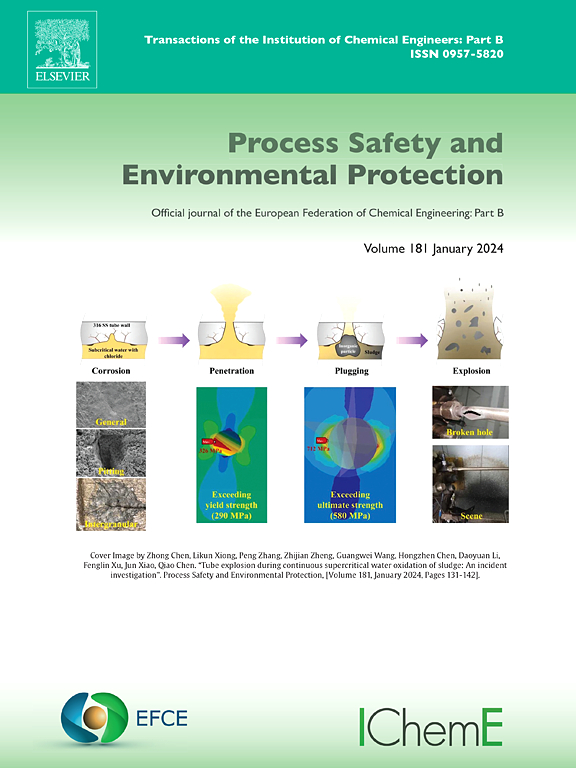MIL-101(Cr)/环氧复合涂料用于混凝土下水道基础设施增强耐腐蚀性
IF 6.9
2区 环境科学与生态学
Q1 ENGINEERING, CHEMICAL
引用次数: 0
摘要
混凝土下水道系统对城市基础设施至关重要,但极易受到微生物腐蚀(MIC)的影响,导致严重的结构退化和大量的维护成本。本研究开发了MIL-101(Cr)/环氧复合涂层,以减轻MIC并提高混凝土在腐蚀性环境中的耐久性。MIL-101(Cr)纳米颗粒通过可扩展的水热工艺合成,并以不同的浓度(0.5 %,1.0 %和1.5 %重量)掺入环氧树脂基质中。优化后的1 wt% MIL-101(Cr)/环氧复合材料具有显著的耐腐蚀性,在硫酸暴露65天后,其重量损失减少到5.2% %,比未涂覆的混凝土性能提高78.3% %,比纯环氧涂层性能提高70.6 %。吸水率降至0.12 %,确保卓越的防潮性和长期耐用性。复合涂层的抗拉强度为6.12 MPa,比传统环氧涂层提高48.5% %,突出了其强大的附着力和结构完整性。热重分析表明,热稳定性得到改善,脱水峰值在173.6°C。密度泛函理论(DFT)计算进一步验证了实验结果,证明了增强的电子给体和电子接受特性有助于复合材料出色的防腐性能。该研究表明,MIL-101(Cr)/环氧复合材料是一种很有前途的可持续解决方案,可以延长腐蚀环境下混凝土下水道基础设施的使用寿命。本文章由计算机程序翻译,如有差异,请以英文原文为准。
MIL-101(Cr)/epoxy composite coating for enhanced corrosion resistance in concrete sewer infrastructure
Concrete sewer systems are essential to urban infrastructure but are highly susceptible to microbial-induced corrosion (MIC), leading to severe structural degradation and substantial maintenance costs. This study develops a MIL-101(Cr)/epoxy composite coating to mitigate MIC and enhance concrete durability in aggressive environments. MIL-101(Cr) nanoparticles were synthesized via a scalable hydrothermal process and incorporated into epoxy matrices at varying concentrations (0.5 %, 1.0 %, and 1.5 % by weight). The optimized 1 wt% MIL-101(Cr)/epoxy composite exhibited remarkable corrosion resistance, reducing weight loss to 5.2 % after 65 days of sulfuric acid exposure, improving performance by 78.3 % over uncoated concrete and 70.6 % over pure epoxy coatings. Water absorption was minimized to 0.12 %, ensuring superior moisture resistance and long-term durability. The composite coating achieved a pull-off strength of 6.12 MPa, a 48.5 % enhancement over conventional epoxy coatings, highlighting its strong adhesion and structural integrity. Thermogravimetric analysis showed improved thermal stability, with dehydration peaking at 173.6 °C. Density Functional Theory (DFT) calculations further validated the experimental findings, demonstrating enhanced electron-donating and electron-accepting properties that contribute to the composite’s outstanding anti-corrosive performance. This study demonstrates that MIL-101(Cr)/epoxy composites are a promising and sustainable solution for extending the service life of concrete sewer infrastructure in corrosive environments.
求助全文
通过发布文献求助,成功后即可免费获取论文全文。
去求助
来源期刊

Process Safety and Environmental Protection
环境科学-工程:化工
CiteScore
11.40
自引率
15.40%
发文量
929
审稿时长
8.0 months
期刊介绍:
The Process Safety and Environmental Protection (PSEP) journal is a leading international publication that focuses on the publication of high-quality, original research papers in the field of engineering, specifically those related to the safety of industrial processes and environmental protection. The journal encourages submissions that present new developments in safety and environmental aspects, particularly those that show how research findings can be applied in process engineering design and practice.
PSEP is particularly interested in research that brings fresh perspectives to established engineering principles, identifies unsolved problems, or suggests directions for future research. The journal also values contributions that push the boundaries of traditional engineering and welcomes multidisciplinary papers.
PSEP's articles are abstracted and indexed by a range of databases and services, which helps to ensure that the journal's research is accessible and recognized in the academic and professional communities. These databases include ANTE, Chemical Abstracts, Chemical Hazards in Industry, Current Contents, Elsevier Engineering Information database, Pascal Francis, Web of Science, Scopus, Engineering Information Database EnCompass LIT (Elsevier), and INSPEC. This wide coverage facilitates the dissemination of the journal's content to a global audience interested in process safety and environmental engineering.
 求助内容:
求助内容: 应助结果提醒方式:
应助结果提醒方式:


